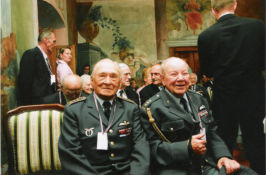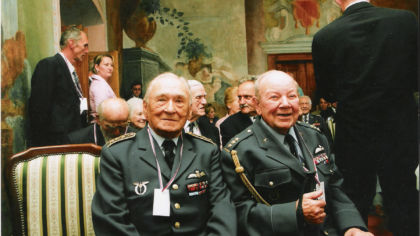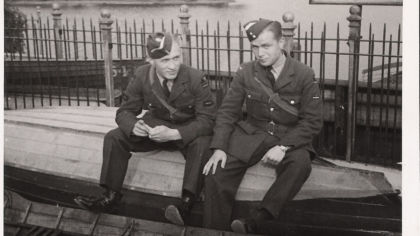Josef Prokopec
A Czechoslovak on the Scene in Normandy
Josef Prokopec, fighter pilot, 310th and 312th Squadron, RAF
On the night of June 5, 1944, one of the most complex military operations of all times was launched – the invasion of Normandy. With all their might, Allied troops attacked the legendary Atlantic Wall, knocked it down, and started to build bridgeheads. Exactly eleven months later, shortly after 8:00 AM, American Sherman tanks would pull up to the main square in Pilsen. At least for the residents of Pilsen, Nazi subjugation permanently became a thing of the past.
Compared to other cities in the Protectorate of Bohemia and Moravia, Pilsen had been through more than its fair share of horrors. This was mainly due to Pilsen’s Škoda Works, the largest armament supplier to the Third Reich. At the end of the war, the city mourned the loss of hundreds of victims – but there had also been many who heard the call of their conscience and left the country to take up arms against Hitler.
One of these men was Josef Prokopec. In the summer of 1939, 20-yr. old Prokopec, who learned to fly at the West Bohemian Air Club in Pilsen and graduated from the program, “A Thousand New Pilots For the Republic”, ran off to Poland to enlist in the newly-developing Czechoslovak Armed Forces Abroad. At that time, he probably scarcely fathomed that it would take five more long years before he would sit in the cockpit of a fighter aircraft. When Poland was invaded by Hitler’s Wehrmacht, on the one side, and Stalin’s Red Army, on the other side, in September of 1939, Prokopec and the other Czechoslovaks had to go on the run once more. He ended up in the Soviet Union where, for months, he awaited transport to the British Isles. Following that, he went to flight school in England and Canada. When he appeared in the fighter squadron, in February of 1944, D-Day was just months away.
It was 4:30 a.m. on June 6, 1944, when the Czechoslovak fighter pilots at the airbase in Appledram were put on battle alert. At that moment, the battle between the Allied paratroopers and German defenders was already in full swing in Normandy. The largest flotilla that the English Channel had ever seen was rapidly approaching the French coast.
“We had roll call at 7 a.m., and not even half an hour later, the first aircraft went into action, operating over the invasion beaches for the next several days. For us, the ‘longest day’ ended at 10:35 p.m., when the last aircraft that had been sent into action that day landed at our base. The sector we patrolled was located to the east of the invasion zone where the British and Canadians landed – roughly from the center of their sector and to the left, toward Le Havre. This was ‘our’ invasion sector – where we kept circling and circling, providing aerial coverage for the troops down below. We didn’t see the Germans, just our own soldiers. There were incredible numbers of them – the invasion rafts streamed to the coast and the landing flotilla seemed endless. The Allied soldiers jumped from the rafts into the water and rushed forward. Tanks, trucks, Jeeps, and lots of other equipment we hadn’t even known existed, were heaved onto the beach, amidst the crowds. From the cockpits of our Spitfires, we watched this incredible ‘theatre’, as if it were on the palms of our hands. We also saw the fire of long-range coastal battery cannons, located west of Arromanches. We weren’t able to gather any more information than this, due to our speed, our altitude, and the fact that we had to take care of the people below us, as well as trying to avoid crashing into our neighbors in the air.
Thanks to the complete absence of Luftwaffe planes, our presence over the battlefield in the first hours of the invasion provided moral support for the troops and their efforts. Aerial attacks from Tactical Air Command Typhoons and two-engine Beaufighters played the main role in destroying the enemy’s fortified positions. We could only attack if the Forward Air Controllers on the ground asked us to. I didn’t fire a single shot in the course of the whole day, but the situation changed dramatically in the following weeks.
Before takeoff, we had a short briefing, where we received the information we needed about planned targets and individual pilot positions in our formation. On that fateful day of June 6, 1944, I flew in the ‘Red Four’ position. The first fighters in our squadron went into action just past seven a.m. After our second wave fighters went up, another three took off. Along with other pilots from the 134th Airfield, I flew in the second ‘wave’ that reached the invasion zone around noon. By then, the landing was in full swing.
West of the British-Canadian sector, there was fierce fighting going on for Omaha Beach. After passing the English shore, an amazing sight spread out below us – a channel completely filled with tiny boats and huge ships. We flew over them at an altitude of at least 1,000 feet. It was a cloudy day and the sea was rough. Our formation’s first flight lasted two hours and, in the afternoon, we went back into action. Again we penetrated into the French interior, in the sector between the coast, Bayeux, and Caen. After returning from the mission, we gathered our things and went to the parachute section to turn in our parachutes. Right after that, we evaluated the flight. We had hardly sat down and ‘Spy’ was already there asking about everything we saw, how the flight went, and whether we had any victories. Our commander was also present at the debriefing. During the invasion, ‘Spy’ drew the advance of the front lines on the map – so that not only we, but also the mechanics and other land personnel, could monitor the troop movements, even if only from a distance.
On June 7, 1944, the day after the second front opened up, my friend, Flight Sergeant Mirek Moravec – a member of the 310th Squadron RAF, like me – was killed shortly after seven a.m., while taking off to patrol the front. Visibility was less than ideal that morning, and the cloud cover stabilized at 8/10 (‘mostly cloudy’). The sky was overcast, but this didn’t change the fact that we had to get the planes into the air, no matter what. The success of Operation Overlord depended on us and our Spitfires, to some extent. The invading forces were already on the coast and were slowly expanding the bridgeheads, but they were still very vulnerable and there was a real threat that the German panzers would push them back out to sea – the consequences of which would be catastrophic. All three of the Czechoslovak fighter squadrons were on patrol three times that day, trying to block the skies over the invasion zone from enemy attack.
The first wave took off after seven a.m. Shortly after that, Mirek lifted his Spitfire off the runway and into the air and wobbled his wings to let his fellow pilots know he had to return – apparently due to a problem with his aircraft. He started to circle, but he couldn’t land right away, because another Spitfire was coming down the runway at the same time. This delay sealed his fate because his Spitfire immediately stalled and, landing gear and flaps down, plummeted to the ground like a rock, crashing about 500 yards from the Appledram airfield. Mirek’s body was trapped inside. A rescue team immediately headed out to him, but Mirek showed no signs of life. His neck was broken. He and I were the same age, had both taken the same route to freedom, and had even gone to the same flight school.
The sudden loss of my friend was devastating for me. Even though it was wartime, and we were putting our lives on the line each and every day, I couldn’t reconcile Mirek’s cruel fate within myself. I missed him everywhere I went. I certainly wasn’t the only one who was affected by his death.
Even in the last moments of his life, Mirek Moravec never knew about the terrible things that had been done to his family two years earlier, in Prague- Žižkov. At that time, the entire Moravec family was actively involved in the Nazi resistance. When Czechoslovak paratroopers came to Prague with plans to assassinate the Deputy Reich-Protector and SS Senior Group Leader, Reinhard Heydrich, the Moravec apartment became an intelligence cell and command center. Paratroopers, Josef Valčík (Silver A group) and Jan Kubiš (Anthropoid group), found temporary shelter in the Moravec home. While they were there, it just so happened that five paratroopers came who had been sent from Great Britain to complete some intelligence work, the most important of which was to carry out the death sentence on Heydrich, the ‘Butcher of Prague’. On the night of April 25, 1942, Valčík, Kubiš and several other paratroopers attempted to guide British bombers to the Škoda armaments factory in Pilsen. The operation, code named ‘Canonbury’, was a failure, and the paratroopers returned to Prague. On May 27, 1942, Gabčík and Kubiš waited for Heydrich on the streets of Prague, and successfully carried out the orders they had received in England. In retaliation, the Germans unleashed a period of terror that Czech society was still trying to recover from years after the war ended.
On June 17, 1942, a Gestapo Commando stormed into the building at Biskupcova Street 7/1745, in Prague-Žižkov. When the police burst into apartment 17, they did not find the paratroopers they were seeking. In the chaos that was unleashed in the apartment, Mirek’s mother poisoned herself with cyanide. Commissars Herschelmann, Chalupský, Bitter, and others apprehended Mirek’s father, Alois Moravec, though Mirek’s younger brother, Vlastimil (nicknamed Aťa), was in Písek at the time. The Gestapo lured him to Prague and immediately arrested him. The same fate awaited Mirek’s fiancée, Věra Löblová, who was apprehended by German security forces, along with her brother and mother.
Vlastimil was only 21 years old when he and his father were killed by the Nazis in Mauthausen. Mirek outlived his brother by just under two years. He knew nothing of the tragic fate of his parents and brother, but he remembered them often while he was in Britain and Canada. The entire Moravec family died in the fight against the Nazis. “When Mirek died, I lost a friend, the likes of whom I would never have again in England,” Josef Prokopec recalled, during the first days of the Normandy invasion.
“Three days after Mirek died, I completed two more two-hour missions. My ‘Spit’ flew flawlessly, but the weather was not in our favor. In addition, some of us found out that there was a lack of fuel. The consequences for the 134th Wing were tragic. When aircraft from our sister 312th Squadron came home that evening, the thick fog caught some of the pilots by surprise. The 12-member formation, under the leadership of Flight Lieutenant Vojtěch Smolík, gave the order, and the planes, in small groups, started to struggle their way to places where they could land. Flight Sergeant Vilém Nosek, Flight Lietenant Smolík’s ‘number two’ man, while looking for a suitable landing site, hit the ground shortly before 7 p.m. about 18 miles from his home base of Appledram. The pilot died in the wreckage of his Spitfire. Flight Lieutenant Smolík’s plane landed on its belly. Five days later, Vilém Nosek was laid to rest alongside my friend, Mirek Moravec, at the cemetery in Chichester,” recalled Josef Prokopec, about the fighting in Normandy. Prokopec was later promoted to the rank of Colonel and decorated with the Czechoslovak War Cross 1939.
Following the communist coup in Czechoslovakia, in February of 1948, Prokopec was persecuted by the communist regime, discharged from the air force, stripped of his decorations, and forcibly evicted from his apartment, along with his family. He was completely rehabilitated forty years later. He died in 2010. Vilém Nosek, a native of Líně, just outside of Pilsen, was also a member of the West Bohemian Air Club before the war, as was Josef Prokopec. This organization produced a number of future ace pilots who served in the Royal Air Force during the war, including Karel Pošta, Jiří Hartman, and Václav Šlouf.
From book 500 hours to victory


